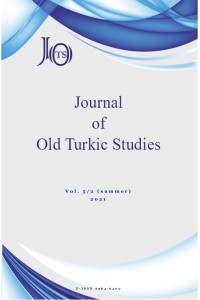Research Article
Year 2021,
Volume: 5 Issue: 2, 296 - 310, 24.07.2021
Abstract
While doing research on Old and Middle Turkic texts, it is important to analyse and solve the meaning structure in order to understand these texts and transfer them to Turkish and other languages. Researchers especially transfer or translate some of the Old Turkic sentences in different meanings. We believe that this problem can be solved by revealing the algorithm of semantic structure of the texts. For this reason, in our research, we use semantic roles, semantic complements, semantic categories, description of verb qualities, text context, semantic structures and valency by keeping and analysing some records of some Old Turkic inscriptions in a combining approach. In revealing the semantic structure of various sentences, it will be explained how to obtain the semantic valency and semantic roles coded in the meaning of a verb in accordance with the text content and the sample sentences will be analysed and shown in practice.
References
- Allerton, D. J. (1982). Valency and the English Verb. Academic Press.
- Clauson, S. G. (1972). An Etymological Dictionary of Pre-Thirteenth-CenturyTurkish. Oxford University Press.
- Erdal, M. (1991). Old Turkic Word Formation, a Functional Approach to the Lexicon I-II. Harrassowitz Verlag.
- Fillmore, Charles, J. (2003). Valency and Semantic Roles: the Concept of Deep Structure Case. In Agel, L. W. et al. (Eds.), Dependency and Valency: an International Handbook of Contemporary Research II (pp. 457-474). De Gruyter Mouton.
- Frawley, W. (1992). Linguistics Semantics. Lawrance Erlbaum.
- Götz-Votteler, K. (2007). Describing Semantic Valency. In Herbest, T. & Götz-Votteler, K. (Eds.), Valency-Theorical, Descriptive and Cognitive Issues (pp. 37-71). De Gruyter Mouton.
- Helbig, G. & Schenkel, W. (1991). Wörterbuch zur Valenz und Distribution deutscher Verben. Max Niemeyer Verlag.
- Herbst, T. & Roe, I. (1996). How Obligatory are Obligatory Complements? An Alternative Approach to the Categorization of Subjects and Other Complements in Valency Grammar. English Studies, 77(2), 179-199.
- Herbst, T. et al. (2004). A Valency Dictionary of English A Corpus-Based Analysis of the Complementation Patterns of English Verbs, Nouns and Adjectives. De Gruyter Mouton.
- Korkmaz, Z. (2003). Gramer Terimleri Sözlüğü. Genişletilmiş 2. Baskı, Türk Dil Kurumu Yayınları.
- Ninio, A. (2006). Language and the Learning Curve, a New Theory of Synatactic Development. Oxford Press.
- Röhrborn, K. (2010). Uigurisches Wörterbuch, Sprachmaterial der vorislamischen türkischen Texte aus Zentralasien I/1: ab- äzüglä-. Franz Steiner Verlag.
- Ružička, R. (1978). Three Aspect of Valence. In Abraham, W. (Ed.), Valence, Semantic Case, and Grammatical Relations, Workshop studies prepared for the 12th International Congress of Linguists, Vienna (August 29th to September 3rd, 1977) (pp. 47-55). John Benjamins Publishing Company.
- Şirin-User, H. (2016). Eski Türk Yazıtları Söz Varlığı İncelemesi. Türk Dil Kurumu Yayınları.
- Tesniére, L. (1959). Les Éléments de syntaxe structural. Klincksieck.
- Tesniére, L. (2015). Elements of Structural Syntax. John Benjamins Publishing Company.
Year 2021,
Volume: 5 Issue: 2, 296 - 310, 24.07.2021
Abstract
While doing research on Old and Middle Turkic texts, it is important to analyse and solve the meaning structure in order to understand these texts and transfer them to Turkish and other languages. Researchers especially transfer or translate some of the Old Turkic sentences in different meanings. We believe that this problem can be solved by revealing the algorithm of semantic structure of the texts. For this reason, in our research, we use semantic roles, semantic complements, semantic categories, description of verb qualities, text context, semantic structures and valency by keeping and analysing some records of some Old Turkic inscriptions in a combining approach. In revealing the semantic structure of various sentences, it will be explained how to obtain the semantic valency and semantic roles coded in the meaning of a verb in accordance with the text content and the sample sentences will be analysed and shown in practice.
References
- Allerton, D. J. (1982). Valency and the English Verb. Academic Press.
- Clauson, S. G. (1972). An Etymological Dictionary of Pre-Thirteenth-CenturyTurkish. Oxford University Press.
- Erdal, M. (1991). Old Turkic Word Formation, a Functional Approach to the Lexicon I-II. Harrassowitz Verlag.
- Fillmore, Charles, J. (2003). Valency and Semantic Roles: the Concept of Deep Structure Case. In Agel, L. W. et al. (Eds.), Dependency and Valency: an International Handbook of Contemporary Research II (pp. 457-474). De Gruyter Mouton.
- Frawley, W. (1992). Linguistics Semantics. Lawrance Erlbaum.
- Götz-Votteler, K. (2007). Describing Semantic Valency. In Herbest, T. & Götz-Votteler, K. (Eds.), Valency-Theorical, Descriptive and Cognitive Issues (pp. 37-71). De Gruyter Mouton.
- Helbig, G. & Schenkel, W. (1991). Wörterbuch zur Valenz und Distribution deutscher Verben. Max Niemeyer Verlag.
- Herbst, T. & Roe, I. (1996). How Obligatory are Obligatory Complements? An Alternative Approach to the Categorization of Subjects and Other Complements in Valency Grammar. English Studies, 77(2), 179-199.
- Herbst, T. et al. (2004). A Valency Dictionary of English A Corpus-Based Analysis of the Complementation Patterns of English Verbs, Nouns and Adjectives. De Gruyter Mouton.
- Korkmaz, Z. (2003). Gramer Terimleri Sözlüğü. Genişletilmiş 2. Baskı, Türk Dil Kurumu Yayınları.
- Ninio, A. (2006). Language and the Learning Curve, a New Theory of Synatactic Development. Oxford Press.
- Röhrborn, K. (2010). Uigurisches Wörterbuch, Sprachmaterial der vorislamischen türkischen Texte aus Zentralasien I/1: ab- äzüglä-. Franz Steiner Verlag.
- Ružička, R. (1978). Three Aspect of Valence. In Abraham, W. (Ed.), Valence, Semantic Case, and Grammatical Relations, Workshop studies prepared for the 12th International Congress of Linguists, Vienna (August 29th to September 3rd, 1977) (pp. 47-55). John Benjamins Publishing Company.
- Şirin-User, H. (2016). Eski Türk Yazıtları Söz Varlığı İncelemesi. Türk Dil Kurumu Yayınları.
- Tesniére, L. (1959). Les Éléments de syntaxe structural. Klincksieck.
- Tesniére, L. (2015). Elements of Structural Syntax. John Benjamins Publishing Company.
There are 16 citations in total.
Details
| Primary Language | Turkish |
|---|---|
| Subjects | Language Studies |
| Journal Section | Research Article |
| Authors | |
| Publication Date | July 24, 2021 |
| Published in Issue | Year 2021 Volume: 5 Issue: 2 |

